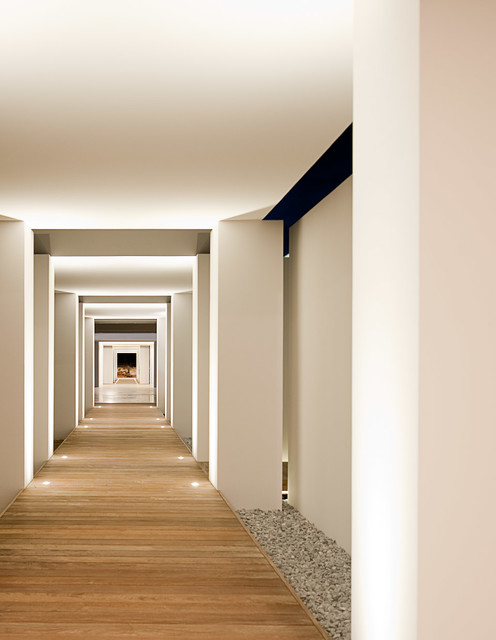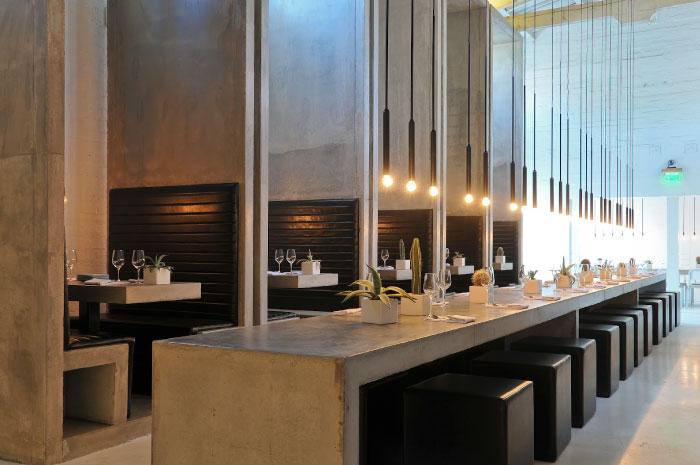Rhythm by gradation or progression. It gives the home interior the extra hint of polish and considered to be the secret behind the success of every interior design.

Principles Of Interior Design Part 2 Rhythm
The use of repetition is the easiest way to attain rhythm and can be achieved by repeating design elements such as lines colors textures and patterns.

. There are three methods of achieving rhythm in interior design. It allows for unity and evolving variety in a design. Serious interior designers should not stop until they feel the appropriate level of rhythm was achieved within a space.
This is newest gallery of Transition Rhythm Interior Design design material. A space that has steady rhythm and repetition will lead the eye around the room seamlessly. The essence of rhythm in interior design is visual repetition of form.
Today she will cover the final principal of interior design. Rhythm may be applied in bold statements that make an obvious suggestion about a path of travel or more subtly applied to move your eye about a space without you even realizing the rhythm is there. It carries the eye along a path at a pace that is comfortable for the viewer.
The proper use of this principle will create excitement and interest within a space. Rhythm is also used to establish a continuity and flow within a room. Rhythm can also be achieved through progression.
Traditionally there are three types of rhythm you can use in your interior design. To achieve a rhythm effect in your design you need to think about design elements or decor in repetition progression transition or contrast. Repetition Transition and Progression Also known as Gradation.
Using these methods will create rhythm through continuity and interest. In an alternating design you use a 1-2-1-2-1-2 pattern. Examples are a gradation of colour or a series of objects that start small and become large in a very regular manner.
Rhythm sets up those patterns leading the eye to the next point and the next and the next. What does rhythm by gradation mean in interior design. All jobs Find your new job today.
Rhythm is how well you execute repetition. Weve always thought rhythm was the most confusing of all of the principles. Balance Rhythm Emphasis and Harmony.
Repetition of shapes Progression of sizes Continuous line of movement. In order to achieve rhythm in your own homes design youll have to think about repetition progression transition and contrast. There are five flavors of rhythm.
See more of radiation rhythm on facebook. Incorporating these mechanisms into your interior youll be able to create a sense of. Suggests connected movement between different elements of interior design.
Applying these visual mechanisms will. Rhythm is the flow from one design element to the next assisting the eyes to move freely throughout an interior environment. It is actually a subtle pattern that takes all of the individual design elements and binds them together.
In interior design rhythm is all about repetition of design elements that help to create movement within a space. Rhythm can be created using the same colours same materials same shapes or even by a progression of smaller to bigger furnishings as you move around the room. In interior design rhythm is all about repetition of design elements that help to create movement within a space.
The flow of elements usually organized according to a scheme such as repetition or alternation progression or graduation transition opposition or contrast or radiation. In interior design rhythm is one of the fundamental elements. Progressive rhythm is a gradual increasing or decreasing in size direction or color.
Well start by defining rhythm within design. Analyzing a piece of music we would describe its rhythmic pattern. Rhythm created by a gradual change in size or color.
Elements can be repeated alternated or arranged in progression to maintain a visual tempo Emphasis. Progression 45 Interior design elements placed according to size from smaller to bigger ones or perhaps according to the gradient of their colours. The ultimate collection of rhythm in art including a rhythm in art definition.
Repetition is the repeated use of a particular design element or structure. A few examples of interior design rhythm repetition and movement could be. The same metal finish carried throughout a room or entire home.
Autumn Rhythm was one of the major works which appeared in that show. The barajas airport by richard rogers and estudio lamela is an excellent example of rhythm achieved through repetition and progression of colour. Size relationships in a.
Rhythm is related movement that directs the eyes towards the lines suggested in the pattern they make together. Rhythm may be applied in bold statements that make an obvious suggestion about a path of travel or more subtly applied to move your eye about a space without you even realizing the rhythm is there. The importance of rhythm in interior design.
Rhythm and repetition is the idea of creating movement and harmony throughout your space with recurring patterns colors and different elements. Like rhythm in music rhythm in design brings a sense of movement to a space. Rhythm is defined as organized repetition or movement.
Rhythm by gradation in interior design. Job Listings From Thousands of Websites in One Simple Search. It can also be created through progression.
Balance depends upon visual weights of the architectural and interior elements -- visual weight is determined by the psychological impact an element makes on us and the the attention it demands. A central piece of art or furniture plays the role of a focal point or attention grabber. A state of equalibrium of the visual forces in a composition.
Other items around the focal point are used to complement it. In interior design rhythm is all about repetition of design elements that help to create movement within a space. Rhythm is created through repetition of line form color or texture.
Principles of Design Rhythm By Radiation 24. Rhythm by gradation progression. The use of the same accent colors.
Rhythm may be applied in bold statements that make an obvious suggestion about a path of travel or more subtly applied to move your eye about a space without you even realizing the rhythm is there. In interior design rhythm is all about repetition of design elements that help to create movement within a space. Rhythm can be created with patterns color structure size or texture.
Learn about the duple meter in music. There are three ways to create rhythm in interior design. Repetition is a common means of creating rhythm and moving the eye through a space.

5 Ways Rhythm Engages Your Eye

How Does Rhythm In Design Engage Your Eyes Your Own Unique Decor

Principles Of Interior Design Part 2 Rhythm

How Does Rhythm In Design Engage Your Eyes Your Own Unique Decor

What Is Rhythm In Interior Design Learn To Apply Tilen Space

Interior Design Principles Rhythm Art Life Fun New Zealand

Rhythm By Repetition 2 Achieved By Repeating Color Line Form Or Texture Architecture Architecture Design Architect House

0 comments
Post a Comment